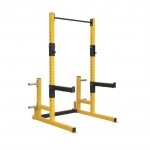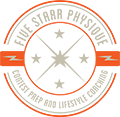When I lived in Asheville I was a member of Biltmore fitness – a very cool gym that was definitely a bit on the…rustic side. It has a very ‘old school’ vibe which I found super appealing. By and large, the people who worked there and trained there were pretty chill, cool people as well. When I moved to Knoxville, the search began for a similar gym within a reasonable driving distance. Unfortunately, none was to be found – so I signed up at the Rush, where my girlfriend was already a member. For those outside the area, the Rush is a regional chain of large box gyms that are very well-equipped, appeal to a wide range of people, is incredibly noisy and ADD-inducing inside, and has the most obnoxious, god-awful color scheme (inside and out) that you could possible imagine.
And it also provides the guarantee that pretty much any time you step foot inside, you’re going to see something that could end up on the Awkward Gym Moments Facebook page. While these events can happen anywhere in the gym, the squat rack is the prime location for bad form, bad decisions, and bad mojo.
Case in point: 3 guys (averaging probably a buck seventy per) taking turns in the rack, “squatting” weights in the neighborhood of 285-355. I use the quotes because I don’t think it counts if the bar only travels 6-8 inches vertically. Knees would shake like a newborn deer on every rep, they would rack the weight, congratulate their bro on a good set, increase the weight and move on. Eventually, one guy officially overdid it: he went down the customary 6-8″, and just kept on going down. Luckily, they did not have the spotting arms of the rack in place and his buddies weren’t paying attention….oh wait, that wasn’t lucky at all. He went down in a hunkered mess to the floor, and I ran over to help while one of his buddies also became alarmed and tried to yank the bar off his back (bad idea dude – you can’t squat that weight, and you also can’t deadlift it or curl it off your buddy). Ultimately we each grabbed a side of the bar and got it off the guy’s back. He was lucky, and managed to walk away. As did his two buddies – without re-racking their weights, of course.
So let’s please learn from these guys. When you go to squat, make sure you know how to do it first. Read a book, watch some YouTube videos, hire a smart and qualified trainer for a single session, whatever – just learn how to do the move correctly first. You are placing a heavy compressive load near your cervical spine and then moving with that load in place. It is very easy to injure yourself doing this if you go about it carelessly. Whether you do a low bar squat (my preference) or a high bar squat, learn where to properly position the bar, how to hold it, how to manipulate your knees and hips in concert with one another through the movement, how to gauge your depth as being too deep, too shallow, or just right, and how to balance your weight distribution between the front and back of your foot.
Find an open rack and claim it. Don’t be afraid to set up shop for a little while, but don’t sit around for 5 minutes between sets either. Do your business and take the time you need to do so, then get out and let someone else use it.

Just the basics, thanks.
Plan ahead. Most racks have adjustable cradles (where the bar sits at rest). Make sure these are at a height where you don’t have to get up on your tip-toes to get the bar positioned on your back. Better to have them too low than too high. Adjust the spotting arms to an appropriate height as well. Warm up with some unweighted squats and look to the side when you’re at your bottom depth, and gauge where to place the arms. Get them in position, do a few more unweighted reps, and adjust as needed.
Start with just the bar. This will not only allow you to determine if you set the arms to the correct depth, but will also be your first reps of the day with weight (not a lot, but still). If you’ve got any kind of minor tweak, irritation, or annoyance in your legs or back, this may be the first thing you do that makes you aware of it. Adjust your plans for the workout accordingly if you feel anything like that.
When you’re ready to go, remember this: the less unnecessary movement you make with the bar on your back, the better. Get the bar on your back, take one small step backward with each foot, and begin. That’s it. Don’t take a ton of little steps back or shuffle your feet endlessly. Know where your feet need to go (you’ll get more confident in this with time) and put them there.
And finally: when in doubt, go light. If you’re accustomed to having someone spot you and find yourself lifting alone one day, make the necessary adjustments in weight (your spotter isn’t there just to catch you but also should be telling you about details and deviations in your form – without those eyes present, back off the gas pedal just a tad). Remember that first and foremost, your job each and every time you enter the gym is to walk out ready to come back the next time. If you let your ego dictate your lifts and get hurt, the missed time in the gym will hurt even more.
Lift safe, and lift smart!
And re-rack your damn weights when you’re done, too.

